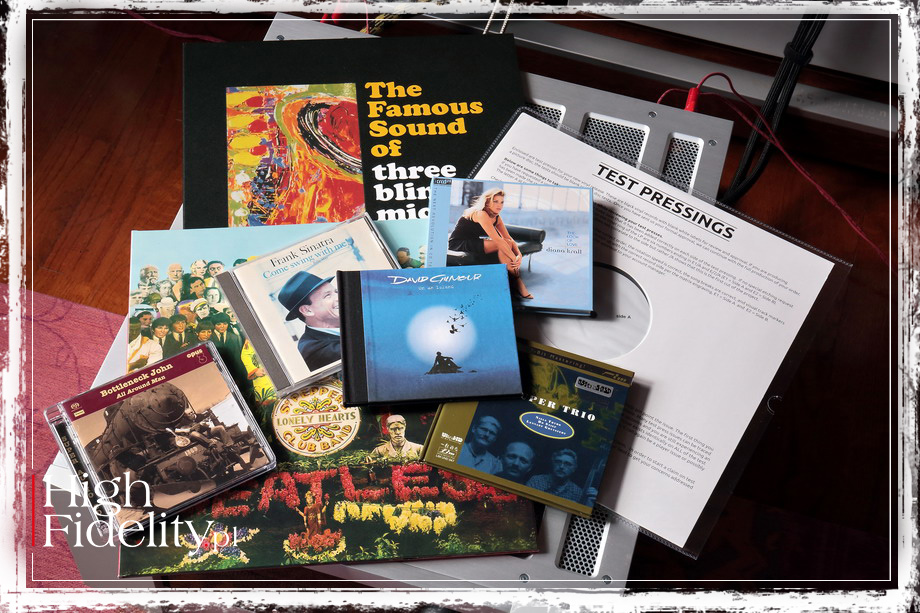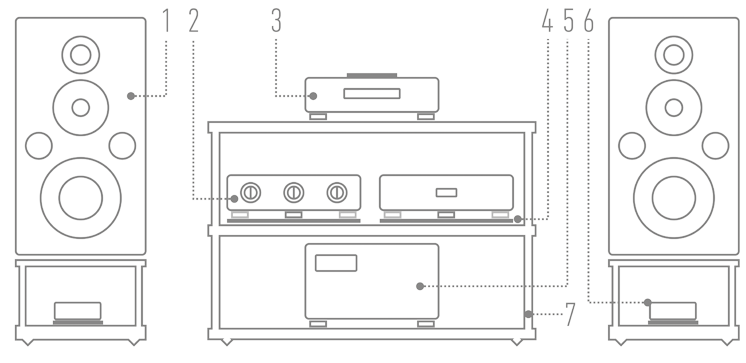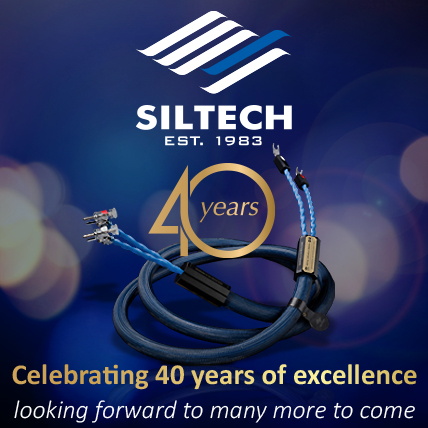|
Integrated amplifier Bladelius
Manufacturer: BLADELIUS DESIGN GROUP |


|

|

| MICHAEL BLADELIUS As he says, he was always interested in electronics and music. He started very early, because he designed and built his first working amplifier when he was thirteen. Life changed for him when, after graduating from high school and before starting technical university, he went to visit friends in Sacramento, California. While being there he found courage and called Nelson Pass, already well-known and respected designer. At that time, in 1988, his guru was working at THRESHOLD, which he had once founded. Even then, that is, before establishing his own company Pass Audio, he was known in audio world, and his name was mentioned along with other "great" ones, such as Mark Levinson, Dan D'Agostino, or William Z. Johnson. Pass must have seen something in the young Swede, because he first invited him for an interview, and shortly after Bladelius returned to Sweden, he called him with a job offer. Our hero did not think long and accepted the offer, then moved to California. He also suspended his education and finished it in the USA, using help of the Swedish consulate. To succeed, he had to prove that he did not take up any work in the USA. The Threshold lawyer helped him to "manage" the situation. To receive the green card, Bladelius wrote a paper on audio amplifiers. The pass – so to speak – to his stay in the US was the doctorate he received for this paper. At the time Michael was working in Threshold, the company underwent ownership changes and was sold to Dynatech in 1988, and Nelson Pass left it in 1991. Mike Bladelius became the head of the design office at that time. Under his leadership, the T2 preamplifier and the T-200 amplifier were developed that for many years were recommended components of the “Stereophile” magazine, in the top "class A”. In 1994, he started self-employment and was hired by various companies as a consultant. In 1994 and1995 he designed devices for the Classé Audio as well as for the ULTRA ANALOG. And the Ultra Analog was an external company that worked for the giants of the high-end world, in addition to the already known to us Threshold and Classé, also for Mark Levinson, designing digital-to-analog converters. The path to running his own company also led through cooperation. Already while working for Threshold, he received a proposal from Werner Barden, a German distributor of high-end brands (Audio Research, Nelson Pass, ProAc, Wadia, Threshold), with whom he designed a prototype of a CD player. It worked out quite well and the gentlemen decided to operate on a larger scale by establishing a company named ADVANTAGE. The division of roles was simple - Michael designed the equipment and Werner sold it. After several years, the distribution business of Bladelius partner began to bear losses, as a result the Advantage company had to be closed quickly. In 1997, the Bladelius company was founded. At the center of its activity are audio amplifiers, but there are also some other devices, such as the Gondul multi-format player, and now Embla - a audio files player with a CD transport. The most important products in brand’s history were: the scalable - from two to five channels, Grendel power amplifier, Beowulf monoblocks and the Ymer amplifier. Olle Mårtensson, the owner of a chain of audio stores in Sweden, distributes Bladelius devices. Let's add that Mike produced several devices under the brand SAT (Swedish Audio Technology) and that during designing and listening sessions he uses different music, but his favorite is Bruce Springsteen and his song titled The Ghost of Tom Joad. I would like to thank Mr. Peter Westberg for his help in preparing this part of the text! | ODEN It won’t be much of an exaggeration if I say that what the Ring of the Nibelung (German: Der Ring des Nibelungen; 1853-1874) by Richard Wagner was for the early 20th century generation, the Marvel Studios movies were for millennials and "Generation Z", including the Thor series. The young generation is therefore familiar with the names I have just quoted - they come from Germanic mythology, and are known mainly from Nordic one. ODEN occupies an important place in them, as one of the most prominent gods, the king of Asgard. He is associated with wisdom, healing powers, death, gallows, knowledge, war, battle, victory, sorcery, poetry, frenzy, and even the runic alphabet; he is depicted as the husband of the goddess Frigg. In the Thor series Odin is played by Sir Anthony Hopkins and Frigga by Rene Russo (Thor: 2011, dir. Kenneth Branagh | Thor: The Dark World: 2013, dir. Alan Taylor | Thor: Ragnarok: 2017, dir. Taika Waititi). Odin, in the Nordic version – ODEN, is also the latest integrated amplifier by Bladelius, a pride and joy of Michael Bladelius.  MIKE BLADEIUS I have been thinking of making a large integrated for the last 10 years. Our new top of the line amplifier, the integrated Oden which has been named from the foremost Viking God in Valhalla. That is indeed something to live up to. About this product we have put down a lot of effort to select its various parts. 
Oden is based on my design philosophy "Simpler is better". It means; you build with as few components as possible, but the ones you use must be of the highest quality. Based on this idea we have reduced the voltage stage in Oden to one (1) in order to create the closet possible signal path. Oden is truly a balanced design without ground as reference. This creates this highest possible performance. The input stage is built with 4 J-FETs, 2 per channel A DC-servo of the highest quality that works outside the signal path and it paves the way for the current loaded, hand matched J-FETs, set up in a foldback cascade arrangement. This gives a linear performance irrespective of the level of the music signal. All this combined with current feedback creates an extremely fast and stable performance. It should be noted that we always uses as little feedback as is absolutely possible. Mostly only use local feedback. 
The very amplification stage is loaded with a large number of MOSFET transistors; 40 very carefully hand matched units. The basic idea is also here; short signal paths, no unnecessary components, low level o feedback, only local. It should be added that a new DC-servo circuit stabilizes the amplification. The circuit is resistant to changes in the operating temperature and magnitude of input signals and it eliminates fluctuations and eliminates fluctuations in sound intensity. The power supply of Oden is equipped with two toroidal transformers 1600VA a piece. They are of the highest possible class for low electrical field and they use a special core material. Oden is also loaded with toroidal inductors to clean up any RF or switching spikes before it will reach the large capacitor bank. Yes in order to increase the purity in the power supply give better response and constant sound performance Oden has a large capacitor bank (200,000 μF). The power bank capacitors are long life high real performance units selected for audio performance not specifications. 
Finally we can add that relays for input select are chosen for their excellent signal transfer with gold plated contact surface. The rectifiers are top of the line not off the shelf ordinary ones - very high speed type. Oden, this particularly prestigious amplifier is a pinnacle my top achievement so far based on 25 years of experience in the audio industry. Most likely, it is the best sounding amplifier in company’s history. ♦ We already know the basics about Oden: it is an integrated stereo amplifier, built with love and tenderness by one of the luminaries of the audio world. It must be added that it is a powerful device, weighing 60kg and measuring 450 x 210 x 550 mm (W x H x D), with a high output of 2 x 400 at 8 Ω and as much as 2 x 800W at 4Ω. It features seven line inputs, two of which are balanced (XLR) and five unbalanced (RCA). Optionally, we can buy an in-built phono preamplifier, on a separate PCB installed inside. This is a MM/MC preamplifier with adjustable gain, so we one can use various types of cartridges with it. The aforementioned gain, the balance between channels, the way to enter the standby mode, display brightness, thermal protections, as well as the sensitivity of the inputs can all be set up in the menu - it is a microprocessor-controlled device; the menu display was placed on the front panel. There are two RCA outputs - one with a signal from preamplifier section and the other is a fix level one (recording loop). There is also room for an optional module - if I had to guess, it can be used for an audio files player, but I can be wrong. | HOW WE LISTENED TO IT One thing is obvious even before we connect the Oden to the power - it's a huge amp. Due to its weight and size, it did not fit on the top shelf of the Finite Elemente Pagode Edition rack that I use. So it stood in front of the rack, i.e. where all components of this caliber, such as: Vitus Audio SIA-030, MOON by Simaudio 860A v2, or Air Tight ATM-3211 had been placed before it. To isolate it from the floor I put it on three anti-vibration feet - the excellent Pro Audio Bono PAB ceramic 80 (with a diameter of 80 mm), and these on two Acoustic Revive anti-vibration platforms: the RST-38H at the back (on two feet) and TB-38H at the front (one foot). I used two signal sources in the test: one analog and one digital. The analogue was the TechDAS Air Force III turntable with the Swedish Audio Technologies LM-9 tonearm and the My Sonic Lab Signature Edition cartridge (output voltage: 0.5 mV, recommended load impedance: 400Ω). The digital source was my Ayon Audio CD-35 HF Edition SACD player (№ 1/50). The signal from the phono preamplifier was sent using an unbalanced cable, and from the SACD player with a balanced one. In both cases they were the Acoustic Revive Triple-C Absolute interconnects. Listening to the in-built phono preamplifier, I connected the cable coming from the SAT tonearm directly to the amplifier.  Recordings used for the test (a selec- tion) | CD & SACD
|
| LP

The Bladelius amplifier inspires respect. It also evokes only positive associations and emotions. Due to its size and robustness, to knowledge and experience accumulated in it, and to its performance. All these elements interact with each other and complement each other, giving this product an internal "compatibility", which treats the sound as something alive, and not a mechanical conversion of the energy of the sound wave into electricity and back. And while ultimately, that's what it is, the best devices, such as the tested amplifier, grow beyond it, being more of work of art than a solidified form of directed energy of their creators. The device delves into the sound with easy and effortlessness. You can tell immediately that the designer wanted to convey the sound in the most smooth way possible. It is a fluidity of silk, but with a "twist". And this time it is not about an "iron fist in a silk glove", as audio journalists sometimes describe a smooth, but also contoured, i.e. unambiguous and "stiff" sound. This is not a contouring sound, that is, the sound attack is not emphasized. The surprise I am talking about is that we are dealing with an absolutely "vintage" sound that is not soft or warmed up at all. I would say it is natural. That's why listening to Bladelius was so comfortable. This is not the most resolving amplifier on Earth, or - even more so - the most selective one. On the other hand, it shows a lot of information. It's just that these are real ’information’, not ’details’. There aren't too many of the latter. So if you like an accurate, precisely timed, slightly hard and expressive presentation - you will have to look elsewhere. Oden is an amplifier that will rather become your friend and not a super-precise tool. 
So we get is an impressively complex sound in terms of tonality and space. These two elements seem to me to be key ones in this case. They are the basis of its philosophy. The tonality because it is rich, well differentiated, just nice. This is not a device that would melt all the recordings into one, shapeless mass, on the contrary, it differentiates them - thanks to the rich palette. Playing the recordings of Frank Sinatra from the Come swing with me! we first hear a bit light band high energy in the upper band with horn in the main role, and then a dense, strong foreground created by the vocals. But when the tube enters, it’s performance is immediately shown as a low, fleshy sound, so it's not like the horns always sound high, but they are differentiated too. With Bladelius, these proportions have been perfectly preserved and conveyed. And why did I mention space as a key quality? - It's simple: it's fantastic. Oden is one of those amplifiers that allow the speakers to "disappear" from the room. On the one hand, because there is something "pulsing" subcutaneously in its sound, as if it were a living creature. I mean the phenomenon in which the sounds flow from underneath, are vivid, not compact and not one-dimensional. Although the device does not show clear 3D bodies, it does not clearly indicate their texture, the bodies themselves are shown perfectly, in perfect proportion to other ones. And that's probably why I enjoyed so much listening to the phenomenal record, which was prepared for - unfortunately canceled - Records Store Day 2020 by Adam Czerwiński from AC Records. It is a 12" maxi single 45 rpm with only two tracks - one taken from the album Piano Sketches and the other from the album recorded with Krzesimir Dębski - Hours. I don't know if you remember, but it was a track that amazed participants of the Krakow Sonic Society meeting. Although we listened to it from the analog "master" tape, we were only slightly less impressed when playing it from the LP. And now we get it in the best possible form - on LP it as the last track, closest to the label, and here it’s the only one on one side of the record. Not to brag but on the cover you will find a short essay by sincerely yours :) Anyway - this is a quiet recording, but with incredible dynamics and spaciousness. Recorded mainly with the large, HUM stereo ribbon microphone, it is spectacular in terms of imaging. We feel like we're sitting in a studio, because we can hear the sound of the double bass, which is further away from us, reflecting off the walls, the drums cymbals in front of us, because this element is always heard more strongly, as well as drums whose sound also comes to us primarily through reflections. It's a sound that literally surrounds us. And Oden feels great in it, it swims in it with the mastery of Michael Phelps. Immediately afterwards I heard something that happens quite rarely, even with very good devices. Fireworks in the opening track of the David Gilmour’s On An Island album in the Castellorizon track that are released IN FRONT of us - it's a quieter, whistling sound, and that explode BEHIND us - it's also a quiet but a crack. The Swedish amplifier turns out to be a champion in this respect and everything I am talking about is not so much just „presented” but rather convincingly „conveyed” because it did it in an unforced, smooth way as part of something bigger. 
The disc in question has a huge scale, even in the CCD version from which I listened to it; more about Copy Protected Disc in the article Copy Control Disc, i.e. anti-format (more to read HERE, HF | № 152 • December 16, 2016). With Bladelius it was clear, because it is an amplifier that builds large, rich images. It slightly pulls up the back layer of the stage, thickening up what is ahead of us. In turn, the elements on the left-right axis it shows in a very wide panorama. So Gilmour's album sounded with the power and energy it deserves. But - and in this way let me return to idea of vintage sound - it is also an amplifier that can deliver a gentle, airily performance, present harmonies, not just the mass of sound. This was the case with discs with classical music - it is an amplifier created for music lovers - but including fans of rock. Reaching for Gilmour once again, let me add that this is why it so beautifully conveyed the harmony between voices of the leader and singing chorus (!) in the title track by David Crosby and Graham Nash. It was fantastic! What won't we get with Oden? - This is not a device that would guarantee a precise presentation of the lowest bass range. I did not miss anything in this sound, but many listeners prefer listening to the music when this range is presented more accurately and more selectively. With classics, jazz - there is no problem, it is a well saturated sound, which translates into credible presentation of music. With rock and electronics, in which bass attack is important, you have to check for yourself if this is what you expect. Also the elements I wrote about at the beginning, that is subtleties and details will not be emphasized here and will not be too expressive. The Hegel H590 and Mark Levinson № 585 will be better choices for this type of tasks, that is to discipline the sound and give it a clear „push”. And this is not about speakers control - Oden does it perfectly, but about the focused "energy" that those amplifiers give to the speakers. | SUMMARY ODEN is one of three integrated amplifiers, next to Vitus Audio SIA-30 and Accuphase E-800 http://highfidelity.pl/@main-3670&lang= < / a>, which can be the basis of even a very expensive system. This does not mean that they are equal in every respect, because their prices are well calculated and correspond to what we get, but only that it is one of the proposals that may be the THE ONE. Bladelius successfully replaces separate amplifiers, even more expensive ones. What's more, it has a great phono preamplifier already on board. It is not as versatile as external devices of this type, but its sound simply captivates with its colors, saturation and melody. It features a solid mechanical design, very good electronic components - these are also strong advantages of the amplifier. It’s a classic, but in a great and modern edition. And there is a bonus: it is an attractively priced amplifier. We would have to pay much more for this type of product from one of the major manufacturers.  The amplifier is made of aluminum plates forming a rigid shell. All plates and heat sinks are screwed to the thicker bottom - transformers, bolted to the front, are the exception. The top is an aluminum truss with holes covered with aluminum mesh - the amplifier gets quite warm during operation, so good ventilation is necessary. The amplifier features four rubber feet - which means that owners can still do a lot in terms of vibration dampening. It is worth trying the Harmonix feet, but also the Pro Audio Bono PAB ceramic 80 feet, with which it was tested. Front and rear | The front is absolutely minimalistic. This is, above all, a medium-sized knob, in a shape characteristic for this company. In the center there are two small displays in greenish color - the larger one shows the volume, and the smaller the selected source and menu messages. To tell you the truth, both should be the size of the former. And there are three more buttons - one turns on standby mode, the other allows you to select an input, and the third changes the brightness of the displays. The rear is quite crowded. Input sockets are arranged in a row - these are solid ones. There are five RCA line inputs, two XLR line inputs and two RCA outputs - from the preamplifier and a recording loop. A little above you can see the RCA phono input and the ground terminal. There are great Mundorf loudspeaker terminals on the sides - same ones as in my Soulution 710 amplifier. There is also an IEC power socket (standard, 16 A) and a mechanical on/off switch. On the side you can see two end caps for optional sockets, and in the middle a transparent, detachable acrylic plate. Preamplifier | The preamplifier is mounted on a large circuit board bolted horizontally to the bottom of the housing. The circuit has been assembled using the classic through-hole method, but here and there surface mounted components can be seen. This is a semiconductor circuit, and the resistor ladder volume control is an integrated circuit. It looks very good, also due to the multitude of Wima polypropylene capacitors, expensive electrolytic capacitors and nice, precise resistors. The inputs are switched in relays. On a separate, smaller PCB we find a phono preamplifier circuit, I think - based on integrated circuits. 
Output stage | The power amplifiers are screwed directly to the heat sinks on the sides of the amplifier. The heat sinks heat up a lot, which suggests that actually a lot of power we get in class A. There are as many as ten complementary pairs (i.e. 20 pieces) of MOSFET transistors per channel. These are very good passive components, such as BC foil capacitors and polypropylene Wima ones. The assembly is hybrid, because some of the elements are surface soldered (SMD) and some are threaded. Power supply | A large part of the interior is occupied by the power supply and it is about 2/3 of Oden's weight. Because this is a dual mono device, we also have two separate power supplies - for the left and right channels. They are based on the powerful Noralet toroidal transformers - 1.6 kW each. They have been bolted to the front of the chassis vertically. The rest of the power supply was mounted on an aluminum plate bolted to the bottom with spacers between. There are sixteen capacitors suppressing power grip ripples, 10,000 μF each, from Vishay. And that's where the 15-amp chokes (1 mH) that were mentioned in the introduction are placed - they were prepared by the Swedish company MicroTraf. The preamplifier has received further levels of filtration, as well as voltage stabilization, already on its board. Remote | The amplifier is supplied with a remote control - a large, full of buttons, made of aluminum, unit. It looks very nice, but it is difficult to navigate. ■  Technical specifications (according to manufacturer) Nominal output: 800 W/4 Ω | 400 W/8 ΩTHD: <0,01% S/N: >125 dB Frequency range: 1 Hz-100 kHz | +0/-3 dB Dimensions (W x H x D): 450 x 210 x 550 mm Weight: 60 kg |

|
Reference system 2018 |
|
 1) Loudspeakers: HARBETH M40.1 |REVIEW| 2) Line preamplifier: AYON AUDIO Spheris III Linestage |REVIEW| 3) Super Audio CD Player: AYON AUDIO CD-35 HF Edition No. 01/50 |REVIEW| 4) Stands (loudspeakers): ACOUSTIC REVIVE (custom) |ABOUT| 5) Power amplifier: SOULUTION 710 6) Loudspeaker filter: SPEC REAL-SOUND PROCESSOR RSP-AZ9EX (prototype) |REVIEW| 7) Hi-Fi rack: FINITE ELEMENTE Pagode Edition |ABOUT| |
|

|
Cables Analog interconnect SACD Player - Line preamplifier: SILTECH Triple Crown (1 m) |ABOUT|Analog interconnect Line preamplifier - Power amplifier: ACOUSTIC REVIVE RCA-1.0 Absolute-FM (1 m) |REVIEW| Speaker cable: SILTECH Triple Crown (2.5 m) |ABOUT| |

|
AC Power Power cable | Mains Power Distribution Block - SACD Player: SILTECH Triple CrownPower (2 m) |ARTICLE| Power cable | Mains Power Distribution Block - Line preamplifier - ACOUSTIC REVIVE Power Reference Triple-C (2 m) |REVIEW| Power cable | Mains Power Distribution Block - Power amplifier - ACROLINK Mexcel 7N-PC9500 |ARTICLE| Power cable | Power Receptacle - Mains Power Distribution Block: ACROLINK Mexcel 7N-PC9500 (2 m) |ARTICLE| Power Receptacle: Acoustic Revive RTP-4eu ULTIMATE |REVIEW| Anti-vibration platform under Acoustic Revive RTP-4eu ULTIMATE: Asura QUALITY RECOVERY SYSTEM Level 1 |REVIEW| Power Supply Conditioner: Acoustic Revive RPC-1 |REVIEW| Power Supply Conditioner: Acoustic Revive RAS-14 Triple-C |REVIEW| Passive filter EMI/RFI: VERICTUM Block |REVIEW| |

|
Anti-vibration Speaker stands: ACOUSTIC REVIVE (custom)Hi-Fi rack: FINITE ELEMENTE Pagode Edition |ABOUT| Anti-vibration platforms: ACOUSTIC REVIVE RAF-48H |ARTICLE| Isolators: |

|
Analogue Phono preamplifier: Phono cartridges:
Clamp: PATHE WINGS Titanium PW-Ti 770 | Limited Edition Record mats:
|

|
Headphones Headphone amplifier: AYON AUDIO HA-3 |REVIEW|Headphones: Headphone Cables: Forza AudioWorks NOIR HYBRID HPC |
main page | archive | contact | kts
© 2009 HighFidelity, design by PikselStudio,
projektowanie stron www: Indecity







 lipping through pages of the Illustrated History of High-End Audio Volume Two: Electronics (published by "The Absolute Sound"), which is something like "Who is who" in the world of top audio electronics, one will not find the name 'Bladelius', nor the name of Mike Bladelius - neither in the main text nor in the index. Which is, let's be honest, a significant omission. Mike Bladelius is one of the most important audio designers. Only that most of his professional life he has spent working for others, often in the role of so-called "Hired gun", or a man for "special tasks". Also, when working under his own name he doesn’t seem to be looking for fame or recognition.
lipping through pages of the Illustrated History of High-End Audio Volume Two: Electronics (published by "The Absolute Sound"), which is something like "Who is who" in the world of top audio electronics, one will not find the name 'Bladelius', nor the name of Mike Bladelius - neither in the main text nor in the index. Which is, let's be honest, a significant omission. Mike Bladelius is one of the most important audio designers. Only that most of his professional life he has spent working for others, often in the role of so-called "Hired gun", or a man for "special tasks". Also, when working under his own name he doesn’t seem to be looking for fame or recognition.



















